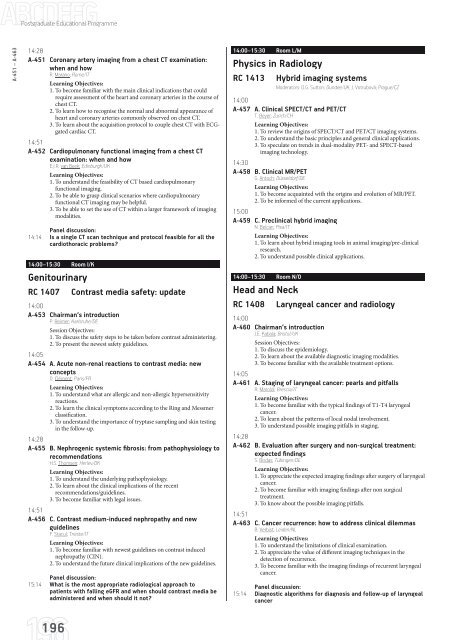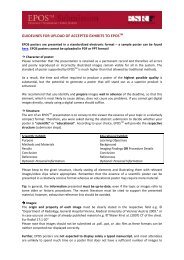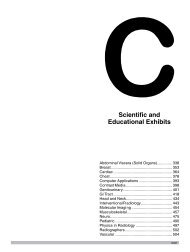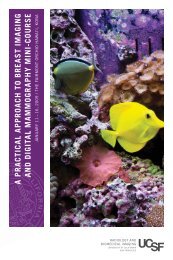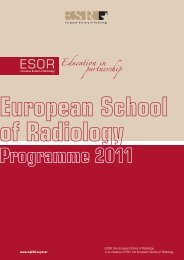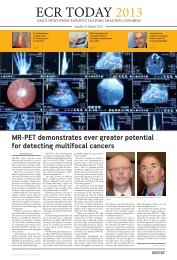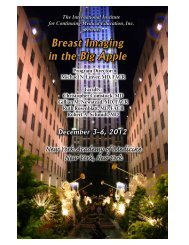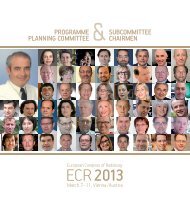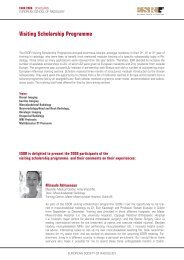ECR 2013 â Final Programme - myESR.org
ECR 2013 â Final Programme - myESR.org
ECR 2013 â Final Programme - myESR.org
- No tags were found...
Create successful ePaper yourself
Turn your PDF publications into a flip-book with our unique Google optimized e-Paper software.
Postgraduate Educational <strong>Programme</strong>A-451 – A-46314:28A-451 Coronary artery imaging from a chest CT examination:when and howR. Marano; Rome/ITLearning Objectives:1. To become familiar with the main clinical indications that couldrequire assessment of the heart and coronary arteries in the course ofchest CT.2. To learn how to recognise the normal and abnormal appearance ofheart and coronary arteries commonly observed on chest CT.3. To learn about the acquisition protocol to couple chest CT with ECGgatedcardiac CT.14:51A-452 Cardiopulmonary functional imaging from a chest CTexamination: when and howE.J.R. van Beek; Edinburgh/UKLearning Objectives:1. To understand the feasibility of CT based cardiopulmonaryfunctional imaging.2. To be able to grasp clinical scenarios where cardiopulmonaryfunctional CT imaging may be helpful.3. To be able to set the use of CT within a larger framework of imagingmodalities.Panel discussion:14:14 Is a single CT scan technique and protocol feasible for all thecardiothoracic problems?14:00–15:30 Room I/KGenitourinaryRC 1407 Contrast media safety: update14:00A-453 Chairman‘s introductionP. Reimer; Karlsruhe/DESession Objectives:1. To discuss the safety steps to be taken before contrast administering.2. To present the newest safety guidelines.14:05A-454 A. Acute non-renal reactions to contrast media: newconceptsO. Clément; Paris/FRLearning Objectives:1. To understand what are allergic and non-allergic hypersensitivityreactions.2. To learn the clinical symptoms according to the Ring and Messmerclassification.3. To understand the importance of tryptase sampling and skin testingin the follow-up.14:28A-455 B. Nephrogenic systemic fibrosis: from pathophysiology torecommendationsH.S. Thomsen; Herlev/DKLearning Objectives:1. To understand the underlying pathophysiology.2. To learn about the clinical implications of the recentrecommendations/guidelines.3. To become familiar with legal issues.14:51A-456 C. Contrast medium-induced nephropathy and newguidelinesF. Stacul; Trieste/ITLearning Objectives:1. To become familiar with newest guidelines on contrast inducednephropathy (CIN).2. To understand the future clinical implications of the new guidelines.Panel discussion:15:14 What is the most appropriate radiological approach topatients with falling eGFR and when should contrast media beadministered and when should it not?14:00–15:30 Room L/MPhysics in RadiologyRC 1413 Hybrid imaging systemsModerators: D.G. Sutton; Dundee/UK, J. Votrubová; Prague/CZ14:00A-457 A. Clinical SPECT/CT and PET/CTT. Beyer; Zurich/CHLearning Objectives:1. To review the origins of SPECT/CT and PET/CT imaging systems.2. To understand the basic principles and general clinical applications.3. To speculate on trends in dual-modality PET- and SPECT-basedimaging technology.14:30A-458 B. Clinical MR/PETG. Antoch; Düsseldorf/DELearning Objectives:1. To become acquainted with the origins and evolution of MR/PET.2. To be informed of the current applications.15:00A-459 C. Preclinical hybrid imagingN. Belcari; Pisa/ITLearning Objectives:1. To learn about hybrid imaging tools in animal imaging/pre-clinicalresearch.2. To understand possible clinical applications.14:00–15:30 Room N/OHead and NeckRC 1408 Laryngeal cancer and radiology14:00A-460 Chairman‘s introductionJ.E. Kabala; Bristol/UKSession Objectives:1. To discuss the epidemiology.2. To learn about the available diagnostic imaging modalities.3. To become familiar with the available treatment options.14:05A-461 A. Staging of laryngeal cancer: pearls and pitfallsR. Maroldi; Brescia/ITLearning Objectives:1. To become familiar with the typical findings of T1-T4 laryngealcancer.2. To learn about the patterns of local nodal involvement.3. To understand possible imaging pitfalls in staging.14:28A-462 B. Evaluation after surgery and non-surgical treatment:expected findingsS. Bisdas; Tübingen/DELearning Objectives:1. To appreciate the expected imaging findings after surgery of laryngealcancer.2. To become familiar with imaging findings after non surgicaltreatment.3. To know about the possible imaging pitfalls.14:51A-463 C. Cancer recurrence: how to address clinical dilemmasB. Verbist; Leiden/NLLearning Objectives:1. To understand the limitations of clinical examination.2. To appreciate the value of different imaging techniques in thedetection of recurrence.3. To become familiar with the imaging findings of recurrent laryngealcancer.Panel discussion:15:14 Diagnostic algorithms for diagnosis and follow-up of laryngealcancer196


